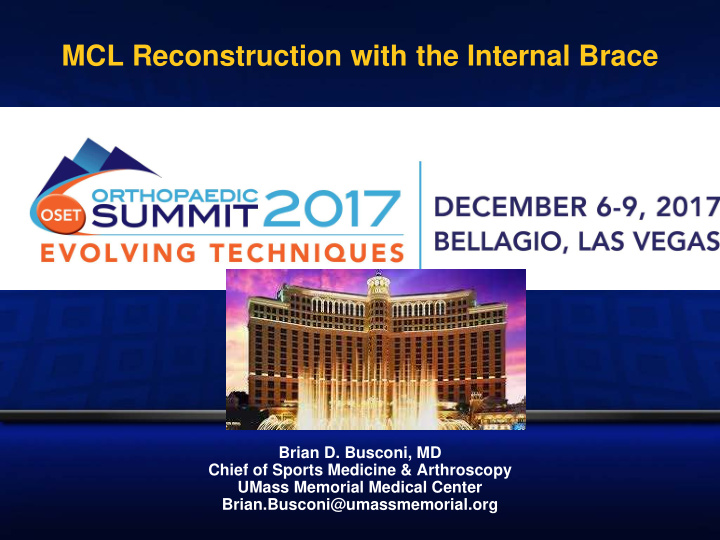



MCL Reconstruction with the Internal Brace Brian D. Busconi, MD Chief of Sports Medicine & Arthroscopy UMass Memorial Medical Center Brian.Busconi@umassmemorial.org
Disclosure • Consultant – Arthrex – Mitek
Current MCL Management • Immobilization • Stiffness, wasting • Residual MCL laxity predisposes to loss of ACL graft tension and rupture • Recurrent instability leads to OA • Failed treatment is expensive
Advantages of Internal Brace • Bridges injured area • Reestablish normal length • Allow healing • Allow early movement • Minimal soft tissue interference or dissection
Anatomy • Superficial MCL • Origin – MFC 3mm proximal/5 mm posterior • Insertion -6 cm distal to Joint line – Under Pes anserine • Biomechanics • Anterior tight in flexion and extension • Posterior tight in full extension • Lax at 30 degrees
Anatomy • Deep MCL – Near joint line – medial menicus – Blends with capsule and POL • Posterior Oblique Ligament – Adductor tubercle to tibial joint line – Loose in flexion • Biomechnics – IR restraint
• Sectioning of Superficial MCL and POL • Increase Knee IR,ER,Anterior translation,Posterior Translation • Combined ACL/MCL – Partial and complete – Increase load on ACL Battaglia et al. AJSM Vol 37, No 2, 2009 • Combined injury – Places ACL at risk
My operative indications • Acute Grade 3 MCL/POL – Avulsion off tibia – Stener lesion • Opens grossly at 0 and 30 • Increased ER • Arthroscope with medial meniscal tear Esp Root • “drive through sign” – Significant Laxity • Hyperlaxity • Obesity – High Demand Athlete
My Operative Indications • Acute grade 3 with combined ligament Injury – ACL/PCL/Corner Injury – Open at 0 and 30 – Increaesd ER/IR – “Drive Through Sign”
My Operative Indications • Chronic MCL/POL Injury – Laprade Technique with reconstruction – Must Evaluate for Mal- alignment
Acute MCL “Drive Through” • 16 yo soccer player • ACL/MCL/Root tear – Opens at 0 and 30 degrees
MCL CL Internal Internal B Brace race • Incisions • Proximal – 3mm above and posterior to epicondyle • Distal –3-5cm distal to joint • Few millimeters proximal to pes anserine and anterior to posteromedial crest of tibia
MCL Internal Brace • 2.4 mm guide pin • 4.5 mm reamer • 4.7 mm tap • 4.75 mm Bio SwiveLock with FiberTape
MCL Internal Brace • Place Distal Tibial Pin • Wrap FiberTape and move the knee • Fix Distal at 20 degrees, neutral rotation ,slight varus • Repair the torn MCL
Final Tips • Ensure the SwiveLock Driver eyelet is fully inserted into the socket • Place a hemostat under the FiberTape to prevent over- constraining • Repair MCL as Needed
Procedure Complete No Gapping even at 30 degrees of flexion with • appropriate Valgus force • Sufficient stability to allow for early movement
What About Chronic Tears?
• Anatomic reconstruction of the sMCL and POL • 4 tunnels, 2 grafts • Semitendinosus graft split into 16 cm (MCL) and 12 cm (POL) lengths • MCL tensioned at 30° • POL tensioned at 0°
Reestablish sMCL and POL Lubowitz JH, MacKay G, Gilmer B. Knee medial collateral ligament and posteromedial corner anatomic repair with internal bracing. Arthrosc Tech. 2014 Aug 11;3(4). 1
Advantages of Internal Brace • Bridges injured area • Reestablish normal length • Allow healing • Allow early movement • Minimal soft tissue interference or dissection
Conclusions • Well established track record in the literature • Eliminates need to rehab MCL prior to ACL reconstruction • Engineered to brace the MCL at the site of injury • Minimally invasive, low morbidity • Affords excellent medial stability in a multi-ligamentous knee
Recommend
More recommend